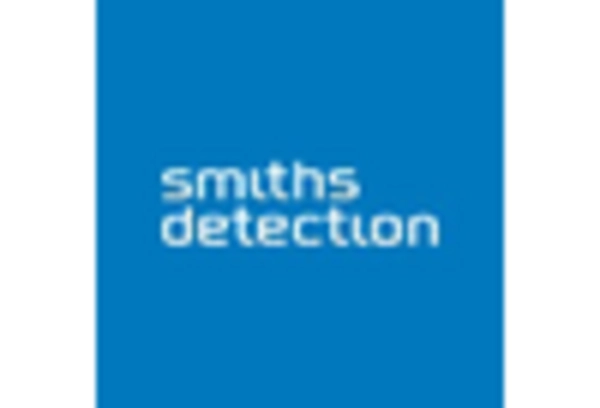Rising Security Threats
The Global airport security Market Industry is increasingly shaped by the emergence of new security threats, including terrorism and cyber-attacks. As threats evolve, airports are compelled to enhance their security protocols to protect passengers and infrastructure. This has led to a surge in demand for advanced screening technologies and surveillance systems. The need for comprehensive security solutions is underscored by the fact that airports must not only secure physical spaces but also safeguard digital information. The heightened focus on addressing these threats is likely to drive substantial investments in security infrastructure, further propelling market growth.
Market Growth Projections
The Global Airport Security Market Industry is projected to experience substantial growth over the next decade. With a current valuation of 5.98 USD Billion in 2024, the market is expected to reach 17.6 USD Billion by 2035. This growth trajectory indicates a compound annual growth rate of 10.32% from 2025 to 2035. Such projections reflect the increasing investments in security technologies and the ongoing need for enhanced safety measures at airports worldwide. As global air traffic continues to rise, the demand for comprehensive security solutions will likely remain a driving force in the industry.
Increasing Global Air Traffic
The Global Airport Security Market Industry is experiencing growth driven by the rising number of air travelers worldwide. In 2024, the market is valued at 5.98 USD Billion, reflecting the increasing demand for enhanced security measures at airports. As passenger numbers are projected to rise significantly, airport authorities are compelled to invest in advanced security technologies. This includes biometric screening and automated security systems, which not only improve efficiency but also enhance passenger experience. The anticipated growth in air traffic necessitates a robust security framework to ensure safety, thereby propelling the market forward.
Regulatory Compliance and Standards
The Global Airport Security Market Industry is significantly influenced by stringent regulatory requirements imposed by governments and international bodies. Compliance with these regulations is essential for maintaining operational licenses and ensuring passenger safety. As regulations evolve, airports are required to upgrade their security measures, which often involves substantial investment in new technologies and training. This regulatory landscape creates a consistent demand for security solutions, thereby driving market growth. The ongoing emphasis on compliance is expected to contribute to a compound annual growth rate of 10.32% from 2025 to 2035, reflecting the importance of adhering to established standards.
Public Awareness and Passenger Expectations
The Global Airport Security Market Industry is also influenced by growing public awareness regarding security issues. Passengers are increasingly concerned about their safety while traveling, which has led to heightened expectations for efficient and effective security measures. Airports are responding by implementing more user-friendly security processes, such as expedited screening and enhanced communication about security protocols. This shift towards prioritizing passenger experience, alongside security, is driving investments in innovative solutions. As the industry adapts to these changing expectations, it is likely to see continued growth, aligning with the overall expansion of the market.
Technological Advancements in Security Systems
Technological innovation plays a pivotal role in shaping the Global Airport Security Market Industry. The integration of artificial intelligence, machine learning, and advanced imaging technologies is transforming traditional security protocols. These advancements allow for more accurate threat detection and faster processing times, which are crucial in high-traffic environments. As airports adopt these technologies, the market is expected to expand, with projections indicating a growth to 17.6 USD Billion by 2035. The continuous evolution of security systems not only addresses current threats but also prepares airports for future challenges, making technology a key driver in the industry.

















